Repair of an Atwater Kent 55 Console
© 2010, Richard Fairbanks
|
 |
| Removal of metal shield reveals more |
|
| What I really want to know is, does the chassis work? I gaze out a window and figure I could just plug it into a light socket to see what happens but no, the sun is still high in the sky. Sparks and flames are much prettier at night and anyway, I can use more careful methods to check the major components.
A dozen bolts secure the chassis bottom. I expect to find filthy webs and animal remains inside but instead find clean and shiny parts. These must be antique "chastity bolts"!
Power supplies in antique electronics usually have age-related failures so that is where I start measuring, with a circuit schematic as my guide (Riders V3, AK3-28).
|
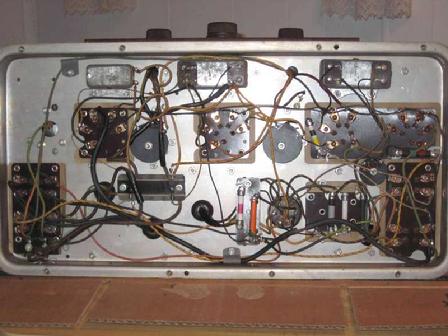 |
| Underside is quite clean! |
|
|
The power transformer is easy to find being the largest (and heaviest!) thing on the chassis. With all tubes removed, I plug it into a variac (variable power source) while measuring each of its four output windings. At a very low and safe voltage, readings on the output windings are plausible so I kick the variac up to full voltage and just sit, quietly listening, sniffing the air. If the transformer has an internal short circuit it will quickly heat up followed by fumes, a few crackles, and eventually a sizzle finish! Okay I lied about being careful! This time though, no odors and no crackles. The transformer is probably okay which is a major relief.
Moving one by one to other coils and transformers I compare resistance readings to what is shown on the schematic. I am lucky. Many schematics do not include resistance readings, which means extra guesswork. Good, good, good, good, uh oh! The speaker field coil measures way less than it should, 650 ohms not 1100 ohms. A cold coil will always measure slightly less until it warms up but this is much too low. The coil may be partially shorted, a disappointing but manageable problem. All other coils pass initial checks and I am confident the radio can be brought back to life without major costs.
The speaker is an Atwater Kent F-4. Its 10” cone does not have a single tear or nick in it, which seems kind of odd considering how beat up and dirty the set is overall. The cone’s surround looks good, real good, and maybe too good. You’d think a hungry mouse would have nibbled on it. Hungry mice nibble on everything. My guess is that either this speaker was repaired or it was swapped out of a different radio.
|
|
My next measurement shows the speaker’s voice coil is a big zero, or should I say a big infinity? I ought to measure a couple of ohms across it but instead there is an open connection. This is where repair begins in earnest.
The speaker's cone is easy to separate from its basket; I pull off a few screws around the edge, release the centering device, and unsolder a couple of flexible terminal wires. The wires dangle freely from the voice coil. That’s odd. Usually they are attached to the cone in some manner and I can see glue remnants along the back where they were originally secured.
The voice coil itself appears undamaged although there is some kind of white powder residue on it. (More about that powder in a moment.) It is obvious why the coil measured as an open circuit and I am now convinced parts of this speaker have been swapped with another. Someone did not bother to re-connect the voice coil after they were done. They just loosely wrapped the coil’s wires to the flexible terminal wires, with no solder and no electrical contact. I notice a turn or two of the voice coil appear to have been removed but it is otherwise perfect. Yeah!
|
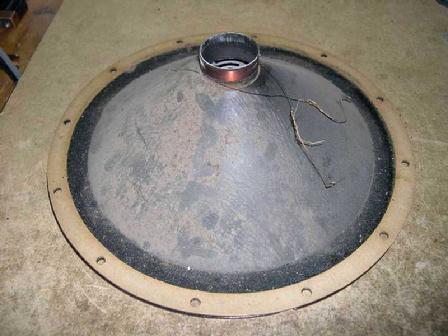 |
| Speaker cone removed |
|
|
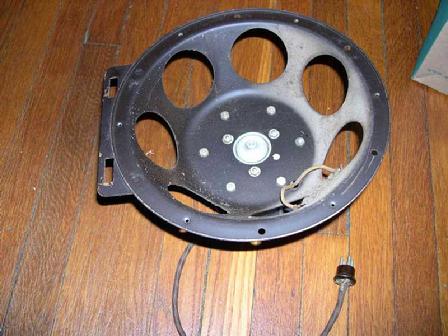 |
| Speaker basket |
|
|
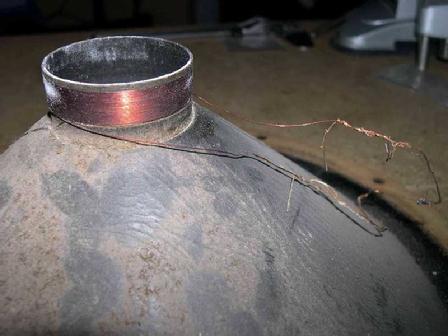 |
| Closeup of voice coil wires |
|
|
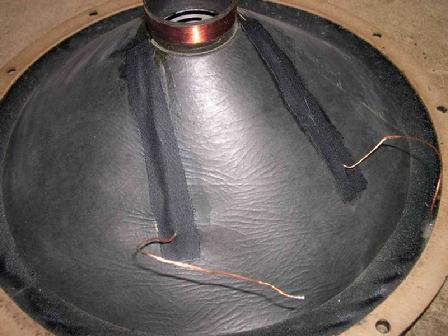 |
| Cloth strips hold terminal wires in place |
|
| The original terminal wires are frayed and too short to reuse. A few strands of fine copper wire will make nice replacements. Rather than glue the wires directly to the paper cone, I use strips of thin cloth to hold them securely. Cloth strips will add a bit of weight to the cone but will be very secure. Any acoustical impact from extra bulk will be negligible.
next-->
|
|
|